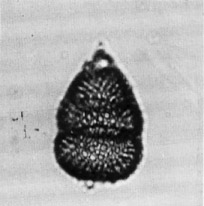 Cyrtocapsella
tetrapera Haeckel
Cyrtocapsella
tetrapera Haeckel Cyrtocapsella
tetrapera Haeckel
Cyrtocapsella
tetrapera HaeckelCyrtocapsa (Cyrtocapsella) tetrapera Haeckel, 1887, p.1512, pl.78, fig.5
Cyrtocapsella tetrapera Haeckel, Sanfilippo and Riedel, 1970, p.453, pl.1, figs.16-18 (with synonymy)
Shell of four segments, with rounded termination. Cephalis spherical, poreless or with a few small pores in some specimens with a short apical horn. Collar stricture moderately pronounced. Thorax conical to hemispherical; third segment annular or inflated; fourth segment hemispherical with a strongly constricted mouth about twice as wide as a pore. Second to fourth segments rather thick-walled with their pores subcircular to circular and rather regular in size and arrangement. Strictures in some specimens rather pronounced, in others not expressed externally. Some specimens have a variable, inverted caplike segment with a thinner wall and less regular pores than in the second to fourth segments (Sanfilippo and Riedel, 1970).
Based on 35 specimens. Total length (excluding horn and fifth segment) 100-140 mm (usually 115-130 mm). Length of second segment 25-45 mm (usually about 35 mm), of third segment 25-40 mm, of fourth segment 30-55 mm. Maximum breadth 75-105 mm (Sanfilippo and Riedel, 1970).
Absence of a more pronounced change in contour between the second and third segments than between the other segments, and the terminal aperture is no wider than about 2 1/2 distal pore diameters. In some specimens a more delicate fifth (and occasionally sixth) segment is present (Riedel and Sanfilippo, 1978a).
Cyrtocapsella tetrapera is generally smaller than C. cornuta, and lacks the pronounced change in contour between the second and third segments that characterizes that species. It differs from four-segmented specimens of Stichocorys delmontensis in having a more robust fourth segment with narrower aperture (Sanfilippo et al., 1985).
The ovoid skeleton of four robust segments is sometimes terminated by a fifth (and rarely even a sixth), more delicate, inverted cap-like closing segment. Cephalis poreless or with a few small pores and in some specimens a short apical horn; thorax conical to hemispherical; third segment annular or inflated; fourth segment inverted hemispherical. Aperture of fourth segment constricted, of varying size but no wider than 2 1/2 times diameter of pores of that segment. External strictures vary from indistinct to pronounced (Sanfilippo et al., 1985).
This species is common in assemblages of late early to middle Miocene age from low and middle latitudes in all oceans, including the Mediterranean region. The last occurrence of C. tetrapera is later in high-latitude N. Atlantic and Antarctic cores than in tropical cores. The morphotypic first appearance of Cyrtocapsella tetrapera defines the lower limit of the Cyrtocapsella tetrapera Zone. The morphotypic last appearance of this species lies within the Diartus petterssoni Zone.
The ancestry of this species has not been traced in detail, but it probably evolved from a form of Eucyrtidium close to Stichocorys delmontensis, by the top four (rather than the top three) segments becoming more robust than the subsequent ones.
Additional illustrations can be found in Sanfilippo et al., 1973, pl.5, figs.4-6; Holdsworth, 1975, pl.2, figs.9, 13-15.